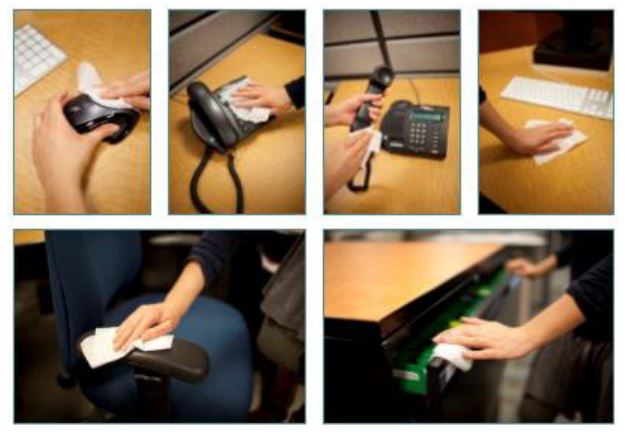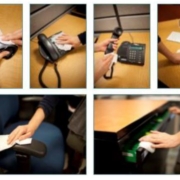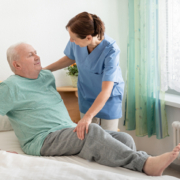WorkStation Cleaning Instructions
/in Coronavirus, Education, NewsA clean office promotes a healthy environment. You have a role in keeping your workstation clean.
During flu season especially, it’s a good idea to clean your workstation regularly.
Follow these three easy steps regularly:
1 Use a disposable disinfectant cloth to wipe down hard surfaces.
These include:
- keyboard
- mouse
- phone
- desktop
- armrests on your char
- cabinet door/drawers
2. Carefully dispose of the clothing immediately after use.
3. Wash your hands with soap and water or an alcohol-based hand sanitizer.

What is Covid-19?
/in Coronavirus, Education, NewsWhat is COVID-19?
What is a Coronavirus?
 Coronaviruses are a family of viruses that can cause respiratory illness in people. Coronaviruses circulate among animals, including camels, cattle, cats, and bats.
Coronaviruses are a family of viruses that can cause respiratory illness in people. Coronaviruses circulate among animals, including camels, cattle, cats, and bats.
How is the Novel Coronavirus, COVID-19 Different from Other Coronaviruses?
Just like there are different types of related viruses that cause smallpox, chickenpox, and monkeypox, different coronaviruses cause different diseases in people. The Severe Acute Respiratory Syndrome (SARS) coronavirus causes SARS and the Middle East Respiratory Syndrome (MERS) coronavirus causes MERS. The novel coronavirus, COVID-19 is one of seven types of known human coronaviruses. COVID-19, like the MERS and SARS coronaviruses, likely evolved from a virus previously found in animals. The remaining known coronaviruses cause a significant percentage of colds in adults and children, and these are not a serious threat for otherwise healthy adults.
What are the Signs and Symptoms of COVID-19 infection?
Patients with confirmed COVID-19 infection have reportedly had mild to severe respiratory illness with symptoms such as fever, cough, and shortness of breath.
What Should I Do if I Think I Have Been Exposed to or Infected with COVID-19?
As a health care provider you have immediate access to local swabbing stations. Go immediately to a swabbing station and tell them you work in healthcare. If you are experiencing symptoms, you should tell your healthcare provider about any recent travel to areas where COVID-19 is
spreading. If you believe you have been exposed on the job, alert your supervisor or clinic immediately.
How is COVID-19 Diagnosed?
Your healthcare provider/hospital can determine if your signs and symptoms are explained by other causes, or if there is reason to suspect you may have COVID-19. If laboratory testing is appropriate, your healthcare provider will work with health officials, who in turn will work with CDC, to collect and test any clinical specimens for diagnosis.
How is COVID-19 Treated?
No vaccine or specific treatment for COVID-19 infection is available currently.
REMEMBER TO FOLLOW ALL CURRENT MENNO PLACE INFORMATION AND TAKE GUIDANCE FROM THE LOCAL HEALTH AUTHORITY, BCCDC AND THE WORLD HEALTH ORGANZIATION.
Point of Care Assessment
/in Education, NewsPoint of Care Risk Assessment Table
The Point of Care Risk Assessment (PCRA) is an assessment performed by healthcare workers and other staff before every resident interaction.
The PCRA will help you decide what Personal Protective Equipment (PPE) to use in order to reduce the risk of exposure to the infectious disease. The PCRA is to ask the following 3 questions and make a decision about what PPE one will wear based on the answers:
- What tasks am I doing with the resident?
- Am I doing direct care or indirect care?
- What is the status of the resident?
- Has the resident been exposed to or diagnosed for the infectious disease?
- Is the resident capable of wearing a surgical mask? (does not refer to a N95 mask)
- Where am I performing my task and are there other people with the infectious disease present?
- Am I performing my task in a room or common area where there are other people infected?
Use the results of the assessment to choose which PPE to use in order to break the chain of transmission and reduce the risk of exposure to the infected person or contaminated areas.
USE OF MATERIALS
All materials available on the www.MennoPlaceStaff.com website are published for the sole purpose of keeping informed those individuals who work on the Menno Place campus. These materials may be shared with others who are also connected to the Menno Place campus in this same way. No content or material may be used or shared in any other context without the written permission of the Menno Place Director who oversees communications.









